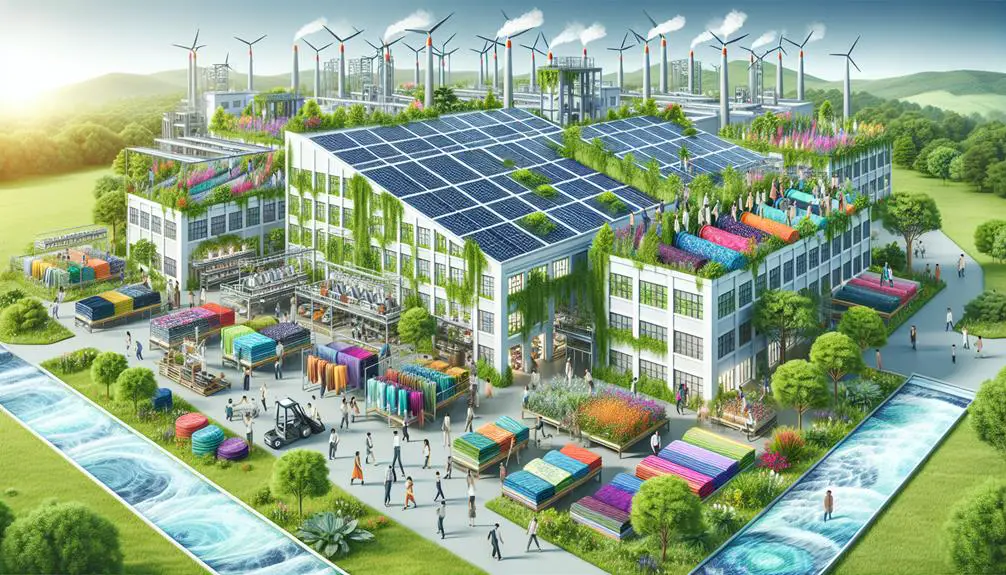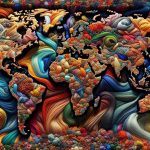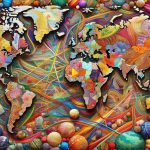Imagine the vibrant colors of a bustling marketplace, where the fabrics on display are not just beautiful but also sustainable. You might wonder how these eco-friendly textiles affect the economy and shape industry trends. As consumer awareness grows and more brands invest in sustainable materials, the fashion landscape is transforming. It's not just about environmental benefits; there are significant economic advantages, too. From cost savings to job creation, the impact is far-reaching. How exactly does this shift influence local economies and the global job market? Let's explore the multifaceted effects of this trend.
Table of Contents
Key Takeaways
- The sustainable fashion market is projected to reach $9.81 billion by 2025, driven by increasing consumer awareness.
- Investments in sustainable materials lead to long-term cost savings, innovation, and enhanced brand reputation.
- Demand for eco-friendly textiles fosters job growth in research, manufacturing, and marketing roles within the textile industry.
- Brands using sustainable fabrics experience higher customer loyalty, influenced by transparency and ethical sourcing.
- Sustainable fabrics like organic cotton and recycled polyester reduce water consumption, carbon footprint, and reliance on harmful chemicals.
Rise of Sustainable Fabrics
Increasingly, sustainable fabrics are becoming the go-to choice for eco-conscious consumers and fashion brands alike. You might wonder why this shift is happening. It all boils down to the innovative materials that are revolutionizing the textile industry and reducing environmental impact to a large extent. Brands are now utilizing fabrics made from organic cotton, bamboo, and even recycled plastics, offering not just style but sustainability.
When you choose these fabrics, you're not just making a fashion statement; you're also contributing to a healthier planet. Organic cotton, for instance, uses less water and zero harmful pesticides compared to conventional cotton. Bamboo grows quickly and requires minimal resources, making it an excellent alternative. Recycled plastics, transformed into stylish, durable fabrics, help mitigate the ocean's plastic pollution problem.
Economic Benefits of Eco-Friendly Textiles
Embracing eco-friendly textiles not only benefits the planet but also drives economic growth and innovation. By integrating sustainable materials into your business, you can leverage several key economic advantages.
First, eco-friendly textiles offer significant cost savings. While the initial investment might be higher, sustainable fabrics often have longer lifespans and require less energy and water during production. This translates to lower long-term operational costs.
Second, the market growth for sustainable products is undeniable. Consumers are becoming increasingly eco-conscious, leading to a surge in demand for environmentally friendly goods. By adopting eco-friendly textiles, you position your brand at the forefront of this expanding market, potentially increasing your customer base and revenue.
Lastly, the industry impact of shifting to sustainable textiles is profound. This movement encourages innovation, driving advancements in fabric technology and supply chain improvements. The positive environmental benefits also enhance your brand's reputation, making it more attractive to investors and stakeholders.
Production Costs and Investments
Understanding the production costs and necessary investments for sustainable fabrics is important for making informed business decisions. You need to take into account several factors, including supply chain efficiency and market competitiveness, to make sure your venture into sustainable textiles is both financially viable and ethically sound.
First, supply chain efficiency plays a vital role. By streamlining processes and reducing waste, you can lower production costs. This often involves investing in advanced technologies and fostering strong relationships with suppliers committed to sustainable sourcing. Such investments not only enhance efficiency but also boost your market competitiveness, allowing you to offer high-quality sustainable fabrics at competitive prices.
Next, sustainable sourcing is a cornerstone of ethical practices in the textile industry. Investing in eco-friendly raw materials might come with higher upfront costs, but it pays off in the long run. Consumers are increasingly looking for products that align with their values, and they're willing to pay a premium for ethically sourced fabrics.
Employment Opportunities and Job Market
The shift toward sustainable fabrics is creating a wealth of new job opportunities across various sectors in the textile industry. As companies pivot to eco-friendly materials, there's a noticeable surge in job growth, which directly impacts the labor force. You'll find that this transformation isn't only benefiting the environment but also paving the way for diverse and specialized roles.
Consider these three primary areas where employment is thriving:
- Research and Development (R&D): Scientists and engineers are in high demand to develop innovative sustainable materials and improve existing ones. These roles require advanced skills and offer substantial career opportunities.
- Manufacturing: The production of sustainable fabrics calls for a workforce trained in new, eco-conscious manufacturing processes. This shift is creating numerous jobs, from machine operators to quality control experts.
- Marketing and Sales: As the market for sustainable textiles expands, there's a growing need for professionals who can effectively promote these products and educate consumers about their benefits.
Consumer Behavior and Demand
As sustainable fabrics create new job opportunities, they're also influencing consumer behavior and driving demand for eco-friendly products. You're not just buying clothes anymore; you're making a statement about ethical sourcing and environmental impact. This shift towards green fashion reflects a deeper awareness of how your choices affect the planet.
Marketing strategies play a pivotal role in this transformation. Brands are now emphasizing transparency, showcasing their commitment to eco-friendly practices. When you see labels highlighting organic materials or zero-waste production, it makes you more inclined to choose those options. By prioritizing ethical sourcing, companies are meeting your demand for products that align with your values.
Your preference for sustainable fabrics isn't just a trend; it's a powerful movement reshaping the fashion industry. You're driving brands to innovate and adopt greener practices. The rise in demand for sustainable fabrics means that green fashion is becoming more accessible and mainstream.
This shift isn't only reducing the environmental impact but also encouraging other industries to adopt similar practices.
Technological Innovations in Fabric Production
In recent years, groundbreaking technologies have revolutionized fabric production, making sustainable options more viable and cost-effective. You're witnessing a transformation in how textiles are made, from the integration of smart textiles to the application of nanotechnology. These advancements aren't just reducing environmental impact but also enhancing fabric functionality.
Smart Textiles: These fabrics are embedded with sensors and conductive fibers, allowing them to interact with the environment. Imagine clothing that can monitor your health or adjust its properties based on temperature changes.
Nanotechnology Applications: This cutting-edge technology enables the creation of fabrics that are more durable, stain-resistant, and even self-cleaning. By manipulating materials at the molecular level, you can achieve remarkable performance enhancements without compromising sustainability.
3D Knitting: This technology minimizes waste by creating garments directly from digital designs. It enables precise customization and notably reduces material waste, aligning perfectly with sustainable fashion goals.
Future Trends in Sustainable Fashion
Building on these technological advancements, you'll soon see groundbreaking trends shaping the future of sustainable fashion. One of the most influential movements is the shift towards a circular economy. This approach emphasizes designing products with their entire lifecycle in mind, ensuring that materials can be reused, repaired, or recycled, thereby achieving zero waste.
You'll be at the forefront of a fashion revolution that prioritizes longevity and resourcefulness over disposability.
Simultaneously, the integration of biodegradable fibers and compostable textiles is set to transform the industry. These materials break down naturally at the end of their life cycle, reducing environmental impact and contributing to zero waste goals.
Imagine wearing garments that not only look good but also return to the earth without leaving a trace.
As a connoisseur of sustainable fashion, you'll appreciate the rise of brands committed to ethical practices and innovative materials. By supporting these trends, you're not just following a fad; you're championing a more sustainable and responsible future.
The fashion landscape is evolving, and your informed choices will play a pivotal role in driving this transformation forward. Embrace these trends, and you'll be part of a movement that redefines style with purpose.
Frequently Asked Questions
What Are the Environmental Benefits of Using Sustainable Fabrics?
You'll find that using sustainable fabrics notably reduces waste and lowers your carbon footprint. By choosing eco-friendly materials, you're actively contributing to a healthier planet and showcasing your commitment to environmental stewardship.
How Does Sustainable Fabric Production Affect Water Consumption?
Did you know sustainable fabrics can reduce water consumption by up to 90% in textile manufacturing? By choosing these materials, you're actively supporting water conservation and helping create a more efficient and responsible production process.
Are There Any Certifications for Sustainable Fabrics?
Yes, there are certifications for sustainable fabrics. You'll find certification standards like GOTS and OEKO-TEX, which guarantee compliance with industry regulations. These certifications assure the fabric's eco-friendly production and ethical manufacturing practices.
What Are the Challenges in Recycling Sustainable Fabrics?
Exploring the maze of recycling eco-friendly fabrics, you hit roadblocks like mixed materials and dye contamination. In working towards a circular economy, these hurdles loom large, contributing to persistent textile waste and complicating the recycling process.
How Can Consumers Identify Truly Sustainable Fabrics?
To identify truly sustainable fabrics, boost your consumer awareness. Look for fabric certifications like GOTS or OEKO-TEX, ensuring they meet rigorous environmental standards. Don't rely solely on labels; research brands' sustainability practices for mastery.
- How Does Ring Spun Cotton Affect Garment Fit and Shape Retention? - August 13, 2024
- What Are the Challenges in Producing Ring Spun Cotton? - August 13, 2024
- Is Ring Spun Cotton Suitable for Plus-Size Clothing? - August 13, 2024






